By Jeffrey A. Rendall, Images Courtesy of Ping Golf
PHOENIX, AZ -- Forgiveness. The word has many connotations, mostly positive. If you fight with your boss, it's good to forgive her (and the other way around); if you're in debt, it's great to receive forgiveness from the bank. If you commit a sin, you might ask for the Lord's forgiveness.
But the word forgiveness also implies that someone's done something wrong. In order to forgive someone, or ask for forgiveness in return, some wrong's in need of righting.
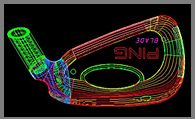 |
In the case of the PING i3+ irons, the forgiveness is for all the right wrongs -- and if you've got an inconsistent golf game, there's no guilt involved whatsoever in asking for it from these clubs.
Forgiveness in the PING sense derives from perimeter weighting -- bet there aren't many who've asked for that kind of pardon before. In the old days, iron heads were forged -- essentially chiseled and formed from blocks of metal, finished by hand. That's why you see players in all the black & white films with tiny, shiny blades, and nowadays you're amazed that they could hit spectacular, accurate shots with such small surfaces.
There was one problem -- those forged irons were designed with the concentration of the weight behind the center, or the 'sweet spot' of the club. Odds and common sense tells us that good players hit the center most often, and therefore enjoyed the most benefits from the golf club head. For the rest of the players -- it was lots of short-game practice.
Now it's a well-known fact that off-center hits in golf clubs cause the club head to twist, which in turn produces a kind of sidespin on the golf ball that nobody wants. Instead of flying straight, the ball hooks or slices, probably to some place that'll require a miracle up-and-down. All things considered, most of us would rather save the short-game tests for a chance to make a birdie on a par five, rather than struggle to save par because a short-iron shot flew the wrong direction.
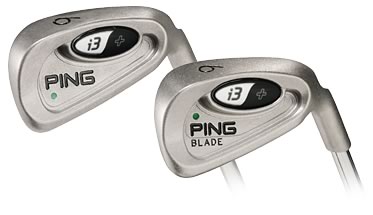 |
| PING i3+ irons. |
PING Golf's inventor and founder, Karsten Solheim (a mechanical engineer by profession), figured that if weight was placed in the toe and heel of golf clubs (he designed his first putter in 1959, then applied the principles to irons a decade later) -- then when the ball is struck away from the sweet spot, the head would resist the twisting that follows from such an imperfect blow. The ball would be a lot more likely to head down the intended target line, and everyone goes away happy.
Hence, the PING putter was born, and succeeding generations of golf club design would never be the same. Today, every golf equipment manufacturer has adopted Solheim's perimeter weighting concept, and most of your recreational players (and even a good many pros) play perimeter weighted irons.
For those who cut their golfing teeth with a set of those less forgiving, tiny forged irons, then switched to a cavity-backed, perimeter weighted cast club, you'll know exactly what I'm saying.
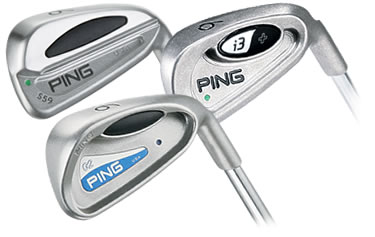 |
| Different looks for different preferences. |
In Solheim's case, the innovation didn't stop there. He also pioneered the investment casting process (which looks not unlike a medieval ceremony of pouring molten metals into molds), and applied much of what he learned in crafting his putters into irons. Solheim's PING EYE 2 irons remain the number one seller in history.
Not bad for a boy born in Bergen, Norway, who didn't even take up golf until he was in his forties.
PING's success is well documented on the professional tours, and PING's irons continue to be amongst the most popular in America. I've known PING owners who've hesitated to try other clubs, even to the extent of denying opportunities to switch to future generations of PING's clubs. Now that's loyalty.
But in this age of rapid technological evolution, even something as time-tested as PING irons evolve and improve. That was the thinking behind the i3+ irons, which I've put into play for a couple months now.
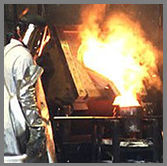 |
| Investment Casting -- a fiery birth. |
Every manufacturer has its thoughts and processes on club-fitting, though I must admit, the PING fitting method seems to stand on its own. I received a personal fitting from PGA teaching pro Rick Zarlengo (formerly at Broad Run), and he took a series of initial measurements, including height, wrist-to-floor, and the length of my longest finger (for grip size).
Then some 'impact tape' was applied to a club, and I hit a few balls off an 'impact board' to determine exactly how my stance and posture affected contact with the ball. I'd been fit before using the tape (for another club maker), so I understood how this tends to work. Because of the results, Zarlengo recommended that my iron shafts be a bit longer than standard, even though I'm about 6'0" in height.
Finally, based on ball flight observations and some inquiries on what I wanted to see out of my irons, Zarlengo made a recommendation. The thoughts were relayed on to the PING folks, and the result was a set of i3+'s custom made just for me (just as every set of PING clubs are).
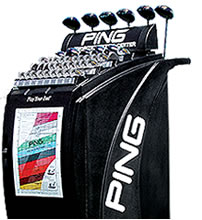 |
| Lots of things to look at during the PING fitting process. |
As mentioned above, the i3+ is an 'upgrade' over the older i3 model, introduced in 1999. John Solheim (Karsten's son), continues the family legacy at PING and acts as company Chairman and CEO, comments on the thinking behind the new 'plus' model: "We've taken the proven technology of our i3 model and fine-tuned it to improve the overall performance of the i3+ irons. We're very excited about these new irons."
Solheim says the lead edge of the i3+ irons contains redesigned contours that lower the face surface, which helps the club head glide through the turf easier and promotes more consistent contact with the golf ball. The club also features new bounce measurements over the previous model. Combining these elements, the i3+ irons offer improved playability for a wide range of lies and playing conditions. Playability's important from your set of irons, since a little forgiveness is often needed in situations that aren't often encountered, or anticipated.
The looks of the PING i3+'s were a fair deviation over my previous sets. The head seems quite a bit larger (almost oversized) and the cavity looks deeper. The looks at address provide what appears to be a large hitting area -- a comforting view for the times when the ball's in deep rough. One of the most important things in considering an iron is what looks good for you -- and the PING i3+ passes the test nicely.
The slightly longer shafts also helped in one regard -- when at address, I needed to hold my hands a bit higher to point the shaft towards my belt, which I'd been told to do by my various teachers in the past (an unintended but beneficial posture adjustment). The grips also seemed a bit thicker then previous clubs, which took a while to get used to.
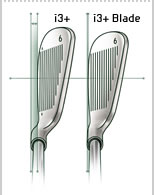 |
| Good looks at address = confidence. |
Striking shots with the i3+'s produced a nice soft feel, and ball-flight distances were consistent with the other high-performance brands I've tried.
And true to the company's philosophy, the irons were very forgiving. When hit off the toe or heel, the ball would still tend to fly straight, with the corresponding loss of distance you'd expect from a mis-hit. I'd say the club's strongest suit involves the superior looks of the heads, and the confidence involved with the product -- that you won't need to be as precise in order to keep the ball in play. True to John Solheim's words, the heads do glide through the turf nicely, and thin shots were held to a minimum.
Just as for any major golf purchase, I'd highly recommend a trip to your local PGA club fitter -- someone who's familiar with the different manufacturers and models, and can not only fit you properly, but also recommend clubs based on the types of playing characteristics you're looking for from your equipment.
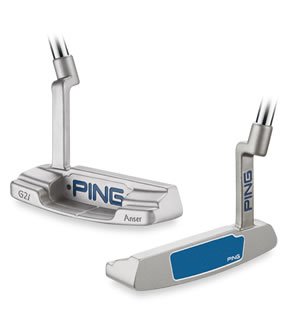 |
| PING's still making some great looking putters. |
I'd recommend the PING i3+'s for anyone who's looking for high-end equipment with some very forgiving qualities, yet yields excellent performance. The i3+ is also available in a blade, designed with less bounce for better players looking to pick the ball cleaner. Try both when you're visiting your PGA professional.
Being fit correctly alleviates the need to forgive anyone for possible mistakes -- and then you might not even need to forgive yourself for buying the wrong clubs.
Details:
The
MSRP $115 per club steel, $150 graphite
Available at your higher-end golf retailers and club pro shops.
| Related Links | Comments on this article? | |
|
Maryland National Golf Club Hollow Creek Golf Club Rocky Gap Resort PB Dye Golf Club in Ijamsville Whiskey Creek Golf Club |
E-mail Jeff Rendall, Editor: jrendall@golftheunitedstates.com |











